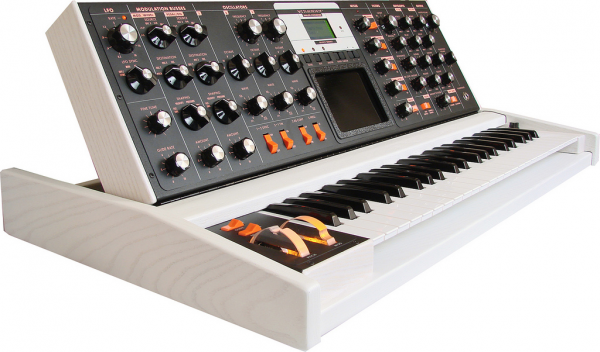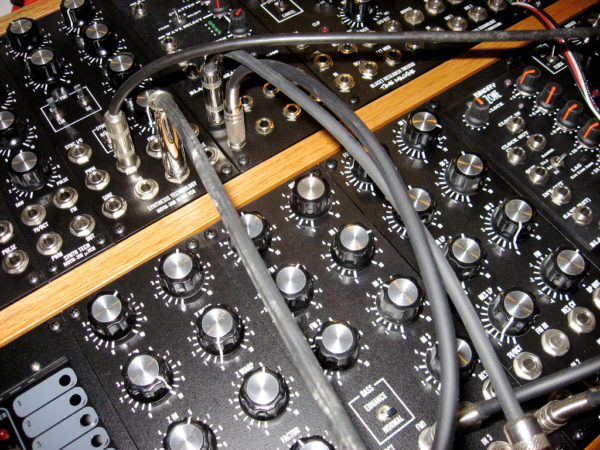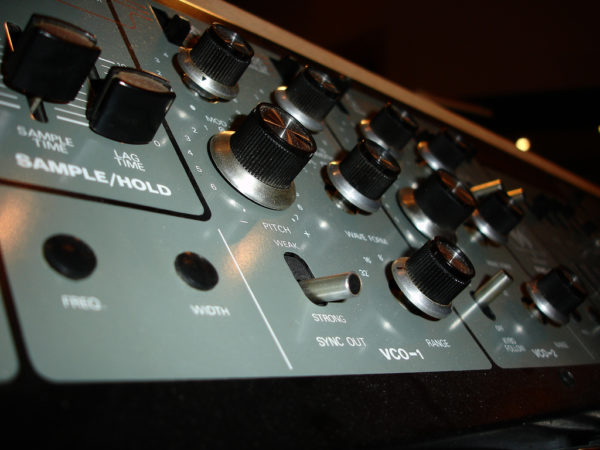Customise the factory presets of your synths, or make your own, in order to find a different, original and disctinctive sound. Stop sounding like everyone else, and sound like yourself. This is our first out of seven “20 Tips” posts, and we have dedicated it to synth programming.

We’ve all experienced the burst of creativity that getting hold of new sounds can bring about – but not being able to afford new synths and sound modules is also a familiar feeling. Simon Lowther offers some tips for creating inspirational new sounds without spending money.
Using the same old tired sounds again and again is frustrating, but it’s all too easy to assume that the only way to get out of the rut is to open your chequebook, when it may be that you’re not exploiting the programming opportunities your existing equipment offers.
Programming sounds can be done by blind twiddling or careful analysis and skilled construction – each approach will produce a different set of results, and both are valid. If you already have a good selection of bread-and-butter sounds in your library (as most instruments do these days), you can just enjoy experimenting and customising.

1. Not all synth parameters have an equal effect on the sound. Some sound-editing parameters make a huge difference and are easy to get at and understand – you can, for instance, do a huge amount with just filter cutoff, envelope attack, release, and LFO depth and amount. Detuning the oscillators is also very effective for getting a fatter, warmer sound.
2. Some simple ideas for a big effect: adjusting the filter settings gives the widest range of new tones. A good place to start is cutoff and the modulation sources that affect it, especially envelope amount, keyboard tracking, keyboard velocity and the settings of the filter envelope. Another area of interest on a sample-and-synthesis instrument is the actual waveforms being processed. Have you ever really stepped through and listened to all the available waveforms in your synth?
3. When inspiration does strike, or you face situations where you are under pressure to get results quickly, a bit of prior preparation helps. Some synths come supplied with software sound-editing templates, including the Korg N5, Waldorf’s Microwave II, and some Yamahas. Of course most synths aren’t like this, so it pays to keep a library of places to start editing from to hand, preferably with favourite envelope settings and modulation routings assigned to your commonly used destinations. I find it especially useful to have multitimbral setups preassigned with sounds and MIDI channels, each given useful relative volumes and effects settings for quickly rolling out new songs. Once you start to craft an arrangement you can start hacking the template to bits and store the result with your song data. Try some housekeeping: store edits of your sounds in a separate file or disk for each project. It’s a wonderful feeling when your creativity is not hampered by spending hours trying to find that missing sound.
4. On those days when inspiration escapes me I need new sounds – but on those days sound-construction inspiration has usually gone too! To get around this I combine existing sounds I like, especially from related synths as they often ‘gel’ together better. Roland Junos and JXs, or Korg PCM synths work very well in this context. You can mix and match layers either as a multi in a Korg or Roland or by importing layers into a program with Proteus and Kurzweil synths. Either way, it’s a quick and easy way of getting new sounds.
5. An arrangement often makes a tune stand out, and sounds are part of this. When programming for a specific tune or arrangement, don’t just concentrate on the strong melodic and bass sounds. Think in terms of time, as well as tone, and look at longer-term sounds. ‘Ambient’ sweeps and other pads can add dimension and space to quite simple arrangements. Make use of evolving sounds – these are not only useful for New Age meanderings. There have been some great examples in recent pop tracks.
6. For much music, and especially dance music, the tempo is everything. There are occasions when the timing of LFO and other modulation sources need to be in keeping with the music to stop things from sounding messy. Depending on which synth you use there may be a setting for sync’ing the LFO to MIDI – it may even be worth checking the manual! The Kurzweil K2000 series instruments require you to select MIDI clock as a modulation source; other synth manufacturers may call it external clock or tempo sync, as on the Roland MC505. It’s worth noting that vibrato in orchestral music is often related to the tempo too, although their vibrato speeds up and down a lot for
expression.
7. If you record a performance involving real-time edits and parameter tweaks into a sequencer, but it does not play back all the aspects of your performance, check to see if you can adjust the MIDI transmit/receive parameters. These are often in the global or MIDI menus. Quite a few instruments (Roland’s JD800 and Juno 106, for example) have selectable settings to save memory or bandwidth. Sometimes instruments have a better MIDI spec than you might think – my old Korg T3 completely surprised me by responding to real-time edits over MIDI!
8. Twiddling with sound parameters while an instrument is sounding adds a great deal to the dynamism and expressiveness of a performance. Play with controllers such as pitch and modulation wheels/joysticks, knobs, footpedals and keyboard velocity and aftertouch. Try experimenting by assigning these to any parameter that seems interesting: you might start with volume, pitch, pan, LFO amount, or filter cutoff.
9. Another way of animating sounds is to use your sequencer as a control module. It’s quite common to record notes and controller information separately. Graphical controller editors in sequencers can enhance the sound, making it as punchy or as lyrical as you need. You can draw in volume patterns, which can create gating effects, or LFO shapes which you can assign to filter and pitch, for example. If your synth has a front-panel data slider that transmits MIDI data, it will probably be sending controller #6. Try remapping this in the sequencer to act as another controller such as pan (#10) or effect depth (#91). Going further, one way to make sounds work well together in a track is to edit with the sequencer running. Tweak sounds in their environment with the full arrangement running. Set the sequencer to loop mode to work on each section individually. Once you concentrate on an arrangement in detail, treating the sounds in the context of the overall mix, you may be surprised how crude some of your previous efforts can sound – I was!
10. The initial attack is the most important part of the sound, as it gives the listener a huge amount of information. I’ve been caught out before when the attack, or the amount of information in the attack portion of the sound, does not fit in with the music. Tracks can sound sloppy and you can’t guess why, because it doesn’t improve when you quantise everything! If this happens, listen to check that the length of sound activity actually fits the arrangement, especially if the tempo of your song has been changed around a lot.

11. Finding or exploring a new or unusual programming permutation opens up a whole area and makes your music fresher to you and quite possibly more interesting to the listener. If your synth allows, try modulating non-standard destinations. For example, modulating the resonance of a low-pass 24dB/octave filter by keyboard velocity softens the tone attack, as increasing the resonance can actually lower the volume on some sounds – or, in the extreme, it may make the filter whistle at high velocities as it self-oscillates. You could use an audio-frequency oscillator to modulate pitch or filter to give a harder tone. If you often use slow LFO sweeps try fast ones for a change and vice versa. Some modulation routings I personally like are:
Slow LFO to filter cutoff giving a slow cyclical timbre change – great on basses and pads.
Keyboard tracking to pan position. If you have two layers, why not go negative on one layer and positive
on the other, to add animation?
Modulation wheel to envelope parameters – this is good on strings and pads.
Control slider to amplifier with two layers, one negative and one positive, gives a crossfade, and can also
be used to make fade-ins and fade-outs of particular layers (this is good with big orchestral layers).
* Velocity to filter parameters, which means sounds are touch-responsive in tone as well as volume. Don’t
forget that aftertouch can be great for sweeps and swells, too. I sometimes find that just adding a simple
vibrato is effective, warming up a static sound nicely.
12. Make the effort to investigate unexplored areas of your synth. For me, the effects processor is a good place, as are the keyboard tracking settings, which can yield all sorts of surprising results as you play along the keyboard. If your synth has a variety of filter modes, have you even explored them? On an S&S instrument, delve a little further into the menus, and try selecting waveforms you don’t usually use.
13. One secret for a devastating bass is to bypass the filter with a sine or triangle wave, and mix it back with a punchy, brighter sound. If your synth will not allow you to do this within a program you could try layering two sounds to achieve the same result.
14. If you recreate vintage sounds on your synth, look at the specs of the original synth you are copying to see what unique features produced the trademark sound. Most SOS readers, for instance, know that the Minimoog is not touch-sensitive, that its two envelopes are unconventional (decay and release times are controlled by the same knob, and a switch turns off the release if desired), that it
has three oscillators, but only two if you want an LFO, and so on. The TB303, which is also frequently recreated, has one oscillator for square or sawtooth waves, an unusual 18dB low-pass filter, and only one simple envelope. Some nifty slur effects are a performance trademark, created with portamento that responds to legato playing.
15. If you really, really want a particular sound, you may just have to use that synth or sample it. Particular types of sounds just fall out of certain instruments and not others. I spent years ignoring this, and struggled to copy sounds with the wrong gear.
16. A quick way of obtaining new sounds is to turn off the onboard effects and play through an external effects unit. And talking of effects, subtle distortion has become popular and is being used to create harder sounds. It is worth exploring as much as delay, chorus, EQ and reverb.
17. If you are swamped in multi-layer mayhem and the result does not sound right, you might find less is more – try using only one VCO or one EG for a change. Simple sounds can provide a punchy and effective contrast.
18. If you feel you know your synths too well and are getting bored, one trick that can work if you have a few instruments is to switch their roles. For example, try using the instrument you usually use for basses to generate pads or even as a piano – assuming it’s polyphonic, of course! PCM workstations can produce unusual percussive bass sounds.
19. Learn to live with one machine for some time and really get to know it. Exploring in depth often yields more personal results. Bringing in a new synth boosts creativity, but sometimes it takes time to get results that do not sound badly dated later on. There have been lots of notorious examples over the years, from DX7 electric pianos to the Roland D50’s ‘Fantasia’ and ‘Digital Native Dance’ patches, various Korg M1 patches such as ‘Pole’, and plenty of sample loops. I suspect that sweeping the entire mix with a low-pass filter will also sound tired in years to come…
20. Conversely, don’t be too afraid of, or snobbish about, factory presets, third-party sounds or even General MIDI if it gets the results you want – lots of respected users have owned up to using them. You only have to listen to some skilful arrangements from commercial MIDI file makers to discover what can be achieved with standard sounds and some lateral thinking.
